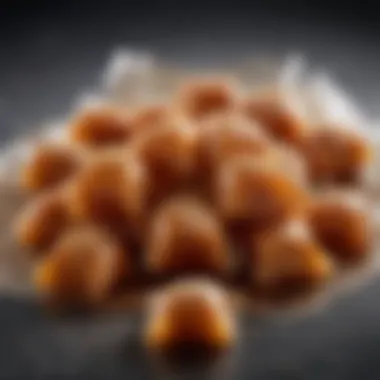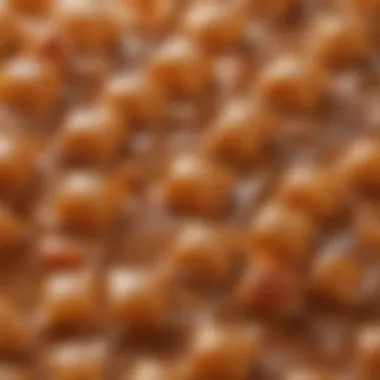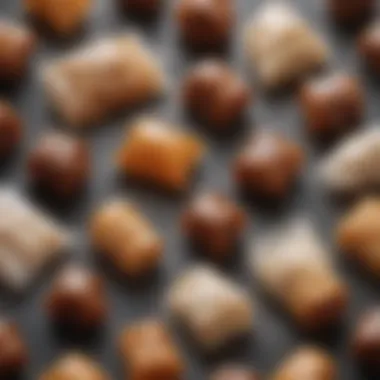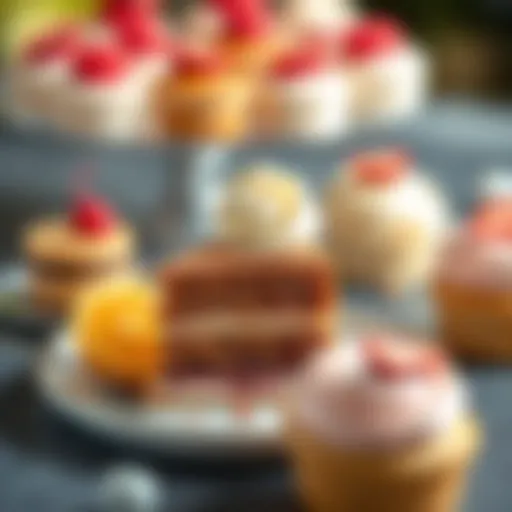The Essential Role of Wax Paper in Caramel Wrapping


Intro
In the realm of confectionery, the nuances of presentation and preservation are often overlooked. When it comes to wrapping delicate caramels, the role of wax paper cannot be emphasized enough. This unassuming material not only serves the practical purpose of keeping the sweets fresh but also plays a pivotal role in maintaining their tantalizing texture and rich flavor. With its unique properties, wax paper emerges as the star player in the packaging game, offering a reliable means to enjoy homemade treats straight from the kitchen.
As we journey through this article, we will examine how wax paper contributes to keeping caramels in peak condition. We will explore the methods of wrapping, delve into alternatives, and discuss practical advice for storage and safety. You'll discover why this seemingly simple material has stood the test of time in the world of candy making, surpassing other options that might lack its distinctive qualities.
So, whether you're a seasoned candy maker or a curious foodie, there's plenty to unwrap in this discussion—join us as we explore the importance of wax paper in the sweet science of caramel wrapping.
Intro to Wax Paper and Caramels
In the world of confectionery, the ability to preserve the quality and appeal of treats is paramount. This is particularly true when it comes to caramels, those rich, chewy delights that can easily become sticky clumps if not handled properly. One often-overlooked hero in this story is wax paper. Knowing how to utilize wax paper effectively can make a world of difference in the experience of not just the creator, but also the lucky recipient indulging in these sugary morsels.
Understanding Wax Paper
Wax paper, as the name suggests, is paper that has been coated with a thin layer of food-grade wax. This simple yet effective creation serves a multitude of purposes in the kitchen and beyond. Whether it's food storage, baking, or wrapping, it has found a place in the hearts of culinary enthusiasts.
The primary benefit of wax paper in candy making is its moisture barrier. Since caramels can easily lose their texture if exposed to air, wrapping them in wax paper creates a shield that helps maintain their chewy consistency. Additionally, it protects the surface from moisture and prevents them from sticking together, which is a common pitfall when storing sweets.
Moreover, the porous nature of wax paper also allows for some level of breathability, which helps in reducing condensation that could lead to a gummy mess. It’s affordable and relatively easy to use, providing an economical solution for wrapping caramels at home.
The Nature of Caramels
Caramels are more than just sugar and butter mixed together. They are a culinary art form, requiring attention to detail and precision. Caramels come in various forms—soft, hard, or chewy—each with its unique texture profile and flavor depth. Generally, they are made by heating sugars until they reach a specific temperature, which changes their physical properties.
As one considers the wrapping of caramels, it’s vital to appreciate their composition. Caramels are typically sticky and moist, meaning that if stored improperly, they will cling to each other or the wrapping material. This is where wax paper shines, acting as a non-stick barrier that keeps individual pieces intact.
Caramels also tend to absorb moisture while they sit, which can alter their taste and texture. Thus, selecting an appropriate wrapping material is crucial. In this context, wax paper offers the perfect balance of protection and practicality, ensuring caramels remain fresh, flavorful, and visually appealing.
"Proper wrapping not only enhances the shelf life of treats like caramels, it’s also a critical factor in the overall taste experience."
In summary, the intersection of wax paper and caramels forms a significant aspect of candy-making discourse. Understanding the properties of both materials paves the way for successful confectionery adventures. Whether you’re a seasoned artisan or a newbie in the kitchen, grasping the fundamentals can elevate your culinary creations.
Properties of Wax Paper
When it comes to wrapping sweet, buttery caramels, the choice of material can make all the difference. Wax paper has been a go-to option for many home cooks and confectioners alike, not just for its traditional role but also for its unique properties that enhance caramel preservation. Below, we will explore specific attributes that make wax paper a favored wrapping material in the world of candies.
Material Composition
Wax paper is particularly noteworthy for its composition. Typically made from thin sheets of paper coated with a layer of wax, this material boasts a certain level of durability. The wax, often derived from paraffin, provides necessary protection against moisture and air, giving caramels an ideal buffer against degradation. When you hold a piece of wax paper, you might notice that it feels smooth and slightly glossy. This is due to the wax coating, which is crucial for keeping caramels wrapped snugly without the fear of sticking.
This material also allows for easy handling; it can be cut and shaped according to the size of the caramel you are wrapping. Unlike plastic wraps that can cling to surfaces, wax paper tends to remain where you place it, leading to fewer frustrations while wrapping. Whether you're a beginner or a seasoned confectioner, working with wax paper offers an element of simplicity and effectiveness.
Moisture Resistance
One of the standout features of wax paper is its moisture resistance. Caramels, which contain a high sugar content and often some fat from butter or cream, are susceptible to moisture. If they absorb too much air or humidity, they can become sticky or lose their texture. This is where the moisture barrier properties of wax paper come into play. The wax coating prevents additional moisture from seeping through to the caramel itself, thus preserving its delightful chewiness and rich flavor.
Moreover, if you were to store caramels wrapped in wax paper, you'd notice they can often remain fresh for a longer time compared to other materials. While the wax paper doesn't seal them in an airtight fashion like plastic wrap might, it does enough to keep them within a suitable moisture range. This balance is essential for maintaining the quality of the candy.
Non-Stick Characteristics
When you think about wrapping sticky caramels, the last thing you'd want is for them to become glued to the wrapping material. This is where the non-stick characteristics of wax paper come in handy. Thanks to its waxy surface, caramels slide right out when unwrapped, preventing the frustrating scenario of losing that sweet treat to the wrapper.
Besides, this property makes handling much more convenient for those who want to manage multiple pieces of caramel at once. If you're preparing a batch for a party, say for a holiday gathering or gifting occasion, the ease of unwrapping can make serving them a breeze. Simply wrap each individually, and when it's time to eat, they come off nice and clean.
In summary, the properties of wax paper—ranging from its material composition to moisture resistance and non-stick features—make it an excellent option for wrapping caramels. By understanding these characteristics, one can appreciate how this humble wrapping paper significantly contributes to the overall experience of enjoying delicious, homemade caramels.
Advantages of Using Wax Paper for Wrapping


Wax paper plays a substantial role in the wrapping of caramels, and its advantages are manifold. Its specific properties make it particularly effective in preserving the quality of this sweet treat, which is why many confectioners swear by it. Let’s dive into the key benefits of using wax paper for wrapping caramels, which can enhance the experience for both makers and consumers alike.
Preservation of Freshness
One of the primary reasons wax paper is favored for wrapping caramels is its ability to preserve freshness. The moisture barrier created by wax paper helps maintain the ideal humidity levels around the candy, preventing it from becoming too hard or overly chewy. Caramels, inherently rich and gooey, can easily dry out when exposed to the air. Wax paper seals the caramels snugly, ensuring that their texture remains just as intended.
By creating a barrier between the candy and environmental elements such as air and light, the risk of spoilage reduces significantly. Food enthusiasts understand the value of enjoying a perfectly textured caramel, and using wax paper aids in achieving that experience. Remember, a chewy caramel that sticks to your teeth is often a product of improper wrapping!
"Choosing the right wrapping material can mean the difference between a delightful treat and a disappointing bite."
Flavor Integrity
When it comes to candy, taste is key. Wax paper not only helps in preserving the cool, sweet taste of caramels but also plays a critical role in maintaining flavor integrity. The properties of wax paper ensure that scents and flavors do not mix, which can happen when using less suitable wrapping materials. For example, stinky plastic wrap may impart undesirable flavors, affecting the quality of your caramels.
Moreover, wax paper is unbleached and free of any harmful additives that could leach into the food. This means that the caramel’s rich buttery notes and flavor profiles — a medley of sweet and salty, in some cases — remain unaltered. This not only enhances the tasting experience but also allows for the full appreciation of artisanal flavors.
Aesthetic Appeal
Lastly, there’s no arguing that wax paper has a certain rustic charm. Its clean, classic appearance adds an element of artisanal quality to the presentation of caramels. For those who love to present their homemade caramels as gifts or at parties, wrapping them in colorful wax paper can enhance their appeal significantly.
The option for different colors and patterns also allows makers to reflect personal style or match the theme of an event. Not only does it keep the contents safe, but it also makes for a pleasing visual presentation that can make your caramels stand out on any dessert table.
In summary, when it comes to the advantages of using wax paper for wrapping caramels, freshness, flavor, and aesthetics all play a critical role in enhancing the overall experience. Whether one is a seasoned confectioner or a casual maker, these advantages are essential to consider.
Alternatives to Wax Paper
When considering the wrapping of caramels, wax paper has long been a favorite due to its flexibility and moisture resistance. However, it’s essential to know that other wrapping materials can serve similar purposes. Exploring these alternatives not only helps you to better understand the functionality of wax paper but also gives you greater choices in the kitchen when wrapping delicate confections. Each alternative has its own set of benefits and considerations, which makes them worth discussing.
Plastic Wrap
Plastic wrap is a ubiquitous choice for many in the realm of kitchen supplies. While some folks might think of it primarily for leftovers, it has a spot in candy wrapping too. The tight seal that plastic wrap creates can be quite beneficial in preserving freshness. When wrapping caramels, this material can lock in moisture, preventing them from drying out.
Furthermore, plastic wrap is transparent, allowing for a glimpse of the candies inside – this can be quite appealing if you’re planning to gift them. However, a couple of caveats exist. Plastic can sometimes stick to caramels in an unyieldy way, making it a bit tricky to unwrap without damaging the candy. Additionally, heat can cause the wrap to cling more tightly, which could be a concern in warmer conditions.
Aluminum Foil
Aluminum foil is another contender you might consider. It’s a durable option that provides a solid barrier against light and air, both of which can detrimentally affect the quality of your caramels. Using aluminum foil helps keep the rich flavors intact, and it does so while also being resistant to grease.
On the other hand, foil lacks that non-stick feature which means there might be some sticking involved. Properly wrapping caramels in foil requires careful folding to avoid contact between the candy and the foil itself, ensuring a smooth release upon unwrapping. It’s worth noting that glue or tape might be needed to keep foil tightly wrapped around the caramel, adding some complexity to the task.
Baking Parchment
Baking parchment is a third viable alternative worth exploring. It’s not only useful for lining baking sheets but also offers a gentle touch when it comes to wrapping caramels. Unlike wax paper, parchment does not possess a waxy layer, but it has non-stick qualities that can work wonders while packaging treats. This means the candy doesn’t cling to the paper, resulting in a cleaner unwrapping process.
Additionally, parchment allows for some breathability, which can be beneficial in preventing moisture buildup. However, it’s essential to keep in mind that baking parchment doesn’t offer the same level of moisture sealing as wax paper does. If you’re in a humid environment, you might find that caramels wrapped in parchment can become a bit tacky over time.
"Choosing the right wrapping material is just as important as choosing the right ingredients for your caramels. Each option has its strengths and weaknesses that can impact the candy’s integrity."
Conclusively, while wax paper has earned its place in the world of wrapping confectionery, alternatives like plastic wrap, aluminum foil, and baking parchment come with unique traits that can enhance or hinder your caramel experience. Understanding what each brings to the table can help you make the right choice based on your specific needs.
Techniques for Effective Wrapping
Wrapping caramels flawlessly involves a few essential techniques that are as applicable as they are critical. Each step—from measuring the wax paper to the sealing—contributes to the preservation of flavor and freshness. Mastery of these methods not only ensures that your treats stay delicious but also that they look appealing for gifting or personal enjoyment.
Cutting Wax Paper to Size
The first step in effectively wrapping caramels is cutting the wax paper to the right dimensions. This task may seem straightforward, but it can greatly affect the end result. Using a pair of sharp scissors, cut the wax paper into squares or rectangles depending on the size of your caramel. For example, 5x5 inch squares are perfect for standard-sized caramels.
When cutting, keep a steady hand; uneven edges can lead to inadequate coverage. It's often wise to cut more pieces than you think you need, as sometimes you may misjudge the size during wrapping. Nothing worse than scrimping on your confectionery, right?


Wrapping Techniques
Now that you have your wax paper cut to size, it’s time to get wrapping. Start by placing the caramel in the center of the square. Fold the wax paper over one side, then the opposite, ensuring a snug fit without crushing the candy. The goal here is to keep the caramel protected while allowing it to breathe slightly; too tight a wrap might cause moisture build-up.
Here’s a simple method you might find handy:
- Step 1: Place the caramel centered on the wax paper square.
- Step 2: Fold one corner of the wax paper over the caramel.
- Step 3: Fold the opposite corner, then repeat for the remaining two corners.
- Step 4: Twist the ends to secure the candy inside, similar to wrapping a piece of candy.
This triangular twist at either end not only helps seal the caramel but gives it a nice, artisanal flair. The presentation can elevate the candy experience, especially in gatherings or as gifts.
Sealing Methods
Sealing is another paramount consideration in wrapping. Various methods exist, each tailored to individual preferences and circumstances. One common technique includes using small pieces of tape to secure the ends after twisting. This is beneficial for softer caramels that might expand or ooze out if not bound securely.
Alternatively, you might prefer not to use tape, opting instead for a more traditional method. Tying a piece of string or ribbon around the ends provides both a seal and an attractive presentation. Not only does it look charming, but it also offers a more rustic aesthetic that many find appealing.
"The simplicity of wax paper wrapping can be likened to a canvas—it requires technique and creativity to produce culinary art."
In summary, the techniques for effective wrapping—whether cutting the paper accurately, employing smart folding methods, or choosing suitable sealing techniques—are vital to maintaining the quality of caramels. These practices ensure that every piece you wrap is not only secured but also presented beautifully.
Storage Considerations
When it comes to maintaining the quality of wrapped caramels, storage considerations take on paramount importance. It's not just about how you wrap them; where and how they are stored can significantly affect their texture and taste over time. Proper storage ensures that the delightful chewiness of caramels remains intact while safeguarding against environmental factors that might jeopardize their freshness. Understanding these elements can make all the difference between biting into a delectable treat or one that has lost its charm.
Optimal Storage Conditions
Creating the right conditions for storing wrapped caramels involves paying attention to several key factors:
- Temperature: A cool environment is ideal. Caramels should be kept away from direct heat sources, as warmth can cause them to melt or become overly soft. Ideally, a temperature range of 65°F to 75°F (18°C to 24°C) is suitable.
- Humidity: Too much moisture in the air can lead to stickiness, while too little can dry out your caramels. Keeping an eye on humidity level is crucial. Using a dehumidifier in damp spaces or placing silica gel packets in the storage area can help regulate moisture.
- Light Exposure: Sunlight can degrade the quality of both the wax paper and the caramels. It's best to store them in opaque containers or in dark cabinets to shield them from light. A wise saying in the culinary world often emphasizes that "out of sight, out of mind" keeps them safe from unexpected spoiling.
Having an understanding of these conditions can facilitate a prolonged shelf life of your delicious caramels, making sure they are always ready to enjoy whenever the mood strikes.
Duration of Freshness
The length of time caramels stay fresh largely depends on both the wrapping technique and storage conditions. Wrapped properly in wax paper, caramels can maintain their delightful flavor and texture for quite a while, usually around two to three weeks at room temperature. However, there are some practices that can extend their freshness:
- Refrigeration: If you want to stretch their lifespan, storing them in the refrigerator can lengthen the duration potentially to a month or more. However, do be cautious: when stored in the fridge, moisture can become a concern, causing the caramels to harden or lose their texture when chilled.
- Freezing: For those looking to hold onto their caramels for an extended period, freezing is an option. When wrapped adequately in wax paper and placed in an airtight container, they can last for up to six months in the freezer. Just don’t forget to allow them to come to room temperature before indulging!
As a point of reference, consider this: "Fresh is best", but a little science in storage can work wonders for longevity and enjoyment. Taking these considerations to heart can ensure that every bite remains as delightful as the first, preserving the integrity of your confectionery efforts.
Creative Culinary Uses of Wax Paper
Wax paper is often thought of merely as a tool to wrap up homemade caramels, but its utility extends far beyond the confectionery world. This flexible and versatile material has found various applications in kitchens, serving both practical and creative purposes. While discussing the role of wax paper in wrapping caramels, it is crucial to explore how this simple paper can elevate culinary experiences and ease various cooking tasks.
Other Confectionery Applications
When it comes to the world of confections, wax paper is a bit of a secret weapon. Beyond caramels, it shines in its ability to wrap fudge, truffles, and similar sweets. The moisture resistance keeps your delicate creations from becoming too sticky while maintaining their shape. These sweets, often meticulously handmade, benefit from the non-stick nature of wax paper, preventing unsightly sticking or tearing when intact. Here are some specific benefits:
- Fudge & Taffy Wrapping: Much like caramels, fudge and taffy can be quite sticky, making wax paper ideal for keeping these treats fresh and intact.
- Preventing Sticking: The wax coating means that you can stack your chocolates or truffles without worrying about them merging together.
- Presentation: Lightly patterned or colored wax paper can enhance the visual appeal of your sweets when presenting them as gifts, especially if you want to impress during holidays or celebrations.
Non-Confectionery Uses
Wax paper is not limited to just candies; it also serves practical roles in other aspects of cooking and food preparation. When working with ingredients that typically result in mess, this paper can save you from a world of hassle. Here are a few notable uses:
- Baking: A clever trick many bakers use involves lining pans with wax paper to avoid sticking when removing baked goods. Although there are more traditional methods, this can help in a pinch.
- Cooking & Marinating: Place meats or vegetables on wax paper while marinating. This prevents the juices from making a mess on surfaces while keeping the flavors in.
- Food Preparation: Use wax paper as a clean surface for chopping or rolling out dough. It greatly simplifies cleanup, as you can just toss the paper away afterward.
- Freezing Small Items: If you've ever frozen herbs or small pieces of fruit, you might appreciate wax paper's ability to act as a barrier, allowing you to stack items without them freezing together.
"Wax paper isn’t just about wrapping candy; it's a silent player in your kitchen that can ease many of your cooking woes."
The versatility of wax paper is often overlooked. Its role extends into numerous culinary practices, aiding in both the confectionery and broader cooking realms. Understanding these myriad applications can significantly enhance the cooking experience, providing both comfort and creativity in the kitchen.


Safety and Health Considerations
When discussing the wrapping of caramels, safety and health considerations are of paramount importance. Consumers today are more aware of food safety standards than ever before. The materials used for wrapping sweets play a crucial role in ensuring that they remain safe to eat and that their quality is preserved. Therefore, it's essential to examine the implications these materials carry, particularly wax paper.
Food Safety Standards
Wax paper typically has a wax coating that makes it moisture-resistant and non-stick. However, not all wax paper is created equal when it comes to food safety. The materials used in the paper and the wax can impact the safety of the wrapped food.
Key standards to keep in mind include:
- FDA Compliance: It’s crucial to ascertain whether the wax paper is approved for food contact by the FDA. This approval confirms that the materials used don't leach harmful substances into the food.
- Correct Usage: Wax paper is not intended for oven use, which could melt the wax and contaminate the food. Knowing these standards ensures safe enjoyment of the candies.
- Storage Practices: Storing caramels wrapped in wax paper in a cool, dry place can help maintain their quality and keep them safe from contaminants.
Environmental Impact
The environmental consequences of using wax paper for wrapping caramels can be both a concern and a point in its favor based on sourcing and disposal practices.
- Biodegradability: Wax paper is often made from paper pulp, which is biodegradable, making it a more environmentally friendly option compared to plastic wraps.
- Sustainable Practices: Choosing wax paper produced from sustainable sources can help mitigate the environmental impact. This allows consumers to enjoy their sweets with a clear conscience.
"Its best to be mindful of what you are using, not just for your health, but for the health of the planet as well."
- Recycling Limitations: While the paper itself can be recycled, the wax coating often complicates the recycling process. This limits how environmentally benign it can truly be.
Consumers, especially those who are environmentally conscious, benefit from understanding these aspects. They can make informed decisions that align with their health standards and ethics.
Historical Context of Wax Paper in Candy Making
The journey of wrapping caramels in wax paper is not just about convenience; it is steeped in history. Understanding this historical context is essential to grasp the significance of wax paper in the confectionery world. Before wax paper became a staple, various methods were employed to wrap sweets, and the evolution of these techniques tells a story about innovation and necessity in food preservation.
Evolution of Wrapping Techniques
Historically, candy makers had to rely on whatever materials were at their disposal. Early methods included using leaves or cloth, practical but often inefficient. In the late 19th century, as industrialization took hold, wax paper emerged as an innovative solution that revolutionized the candy-wrapping scene. It offered a unique combination of moisture resistance and flexibility. The application of natural wax to paper allowed for a barrier that kept moisture in and out, which was particularly crucial for sticky confections like caramels.
- 1870s-1880s: The first instances of wax paper usage in candy stores.
- 1920s: Wax paper became popular, with its production ramping up to meet consumer demand.
- Post World War II: Advances in manufacturing led to even better coatings, enhancing performance and aesthetics.
The ability to print on wax paper also added an artistic flair, turning simple pieces into marketing tools that showcased brand identities. Manufacturers could now easily display vibrant colors and attractive designs that drew in potential buyers.
Cultural Significance of Candy Wrapping
The importance of how candy is wrapped extends beyond mere utility. Wrapping not only protects the product but also plays a critical role in cultural traditions. In many cultures, giving sweets wrapped in decorative paper signifies hospitality and celebration. For example, during festivals, families often exchange homemade caramels wrapped in beautifully decorated wax paper, as a sign of sharing and goodwill.
"Wrapping sweets in vibrant, printed wax paper is a tradition that turns a simple gesture into an expression of love."
The custom of wrapping caramels has evolved into an art form in itself. Each design tells a story, whether it’s simple elegance or an explosion of colors, incorporating local motifs, symbols, and even seasonal themes. In this way, wax paper has become not just a functional item but also a canvas for cultural expression.
As candy making continues to evolve, the role of wax paper remains relevant, merging the past with the modern culinary landscape. The historical context of wax paper in candy making is not only crucial for understanding its functional aspects but also highlights its culturally significant role in celebrations and gifting traditions across the globe.
Finale
The conclusion of this article on the use of wax paper in wrapping caramels brings to light several key aspects that underline its vital role in candy making. If you think about it, when you're dealing with sweets, especially something as delicate as caramels, the way they're presented and preserved is just as significant as the flavor itself.
Summarizing Key Points
In reviewing the details shared throughout the article, we noted a few standout elements that highlight why wax paper should be a go-to material for wrapping caramels.
- Material Properties: Wax paper is moisture-resistant and boasts non-stick qualities, making it perfect for clingy confections like caramels.
- Preserving Freshness: The natural barrier that wax paper offers ensures that caramels maintain their texture and taste longer, protecting them from air and moisture that could spoil them.
- Aesthetic Appeal: Not only does wax paper provide practical benefits, but it also serves as an attractive wrapping that enhances the visual appeal of caramels, making them look almost as good as they taste.
All these points weave together a strong case for wax paper as an optimal choice in the confectionery world. It's not just about functionality; it's about creating an experience that delights not just the taste buds but the eyes as well.
Future Perspectives on Wax Paper Use
Looking ahead, the use of wax paper in wrapping techniques is likely to evolve as consumer preferences shift towards more sustainable options. There’s increasing awareness about environmental impacts, leading manufacturers to consider eco-friendly wax papers that do not compromise on quality. Future innovations might incorporate biodegradable materials or enhanced formulations that make wax paper even more effective in preserving confectionery delights.
The culinary landscape is constantly changing, and so is the market for packaging materials. As food lovers continue to experiment in kitchens around the globe, the versatility of wax paper could see further applications beyond just caramels. From artisanal chocolates to gourmet cheeses, the invitation for wax paper to take center stage in food presentation seems ever-expanding.
Ultimately, the journey of wax paper is just beginning. As more people recognize its benefits, the choice to use wax paper in wrapping sweets could become a staple in modern candy making. The fusion of tradition with innovation will define how we wrap and preserve our culinary creations for generations to come.















